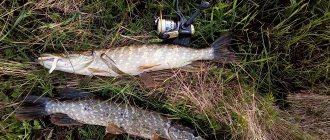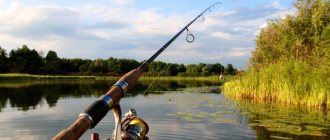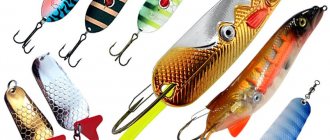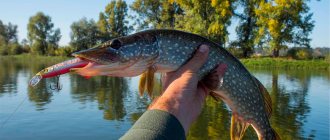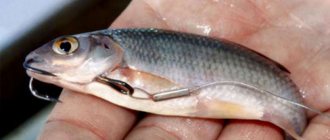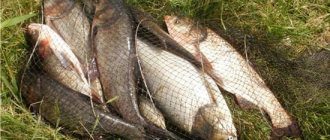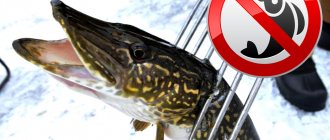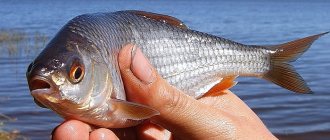A spinner or spinner is one of the most popular and effective baits for catching predators, particularly pike. This is the most common bait when fishing with spinning rods. Any beginning spinning player will have one or another spinner in his drawer. Professionals have long chosen their favorites among baits and have not changed them for many years.
Pinwheels are considered the most reliable baits for catching toothed predators. The spinners demonstrate their effectiveness both in active feeding and in the quiet absence of biting. They have proven themselves excellent in almost all bodies of water where predators live. Anglers naturally ask: “Why is the spinner so successful?” The fact is that a rotating spoon creates an oscillatory circuit, which is attractive to predators at a long distance. The spinners emit a vibration that matches the vibration of the wounded fish. The pike picks up these vibrations at a distance of up to 20 meters and attacks quickly and fearlessly. By choosing the correct mode of wiring, you can use a spinner to make the pike believe that there is a wounded fish in front of it. These vibrations are created by the structure of the pinwheel.
A pike spinner is a piece of a streamlined metal plate that is loosely threaded onto a rigid rod. Under water pressure, the structure creates a force that rotates the petal and creates vibrations. This is what fascinates the predator and makes it attack without hesitation.
How to choose a spinner for pike
Despite the fact that the spinner for pike is guaranteed to work, you need to pay special attention to the selection of the spinner. The fact is that not a single spoon will catch pike equally at depth and on the surface, in spring and summer. For successful fishing you need to choose a set of working spinners. To choose the right spinners for pike, you need to pay attention to some factors.
When choosing a pinwheel, you need to pay attention to the shape of the petal. It is the shape of the petal that will determine the performance of the bait in the current or in its absence. Traditionally, there are three classes of spinners: Aglia, Aglia Long, Comet. The Aglia spinner has a large and convex petal, which makes it indispensable when fishing downstream. The Aglia long pinwheel owes its name to its shape; it is long and narrow. This spinner is used against the current. The comet has an oval shape and is ideal for fishing in deep water.
The weight and size of the spinner affects the depth of the dive. The seasonality factor is also extremely important, because the predator behaves differently in different temperature conditions. At a water temperature of 10 to 15 degrees Celsius, you should use spinners with long petals, and in warm water with round ones, the rotation speed of which is much higher. In general, in warm water the predator is more active. The main condition for successful fishing: the bait is correctly selected for the circumstances and its high-quality execution.
Wiring of front-loaded turntables
In principle, there is nothing particularly complicated about it. I use wave-like wiring in the water column, and I make the rise of the spoon sharper than its dive. But all simple things, as a rule, if you understand them well, have many nuances. The main one is how to ensure that the spoon is positioned exactly in the desired horizon, that is, in the immediate vicinity of the bottom or aquatic plants covering it. There are two ways here - selecting the weight of the load or the speed of the drive. In my opinion, it is better to choose the first one. If you install a load that is too light, then at a relatively large depth the spoon will not work properly; if, on the contrary, the load is too heavy, then the spoon will go too fast and will no longer be attractive to a predator. But “too heavy” and “too fast” are, frankly, subjective. I have chosen a specific wiring speed for myself and try to stick to it, deviating slightly in one direction or another, depending on the “mood” of the predator. That is, for me personally, the largest number of bites occur precisely at this wiring speed.
But my friend prefers a much faster retrieve, and where I would fish with a spoon with a load of, say, 7 grams, he will put at least fifteen. ?? he has a great pike bite at this fishing speed, although if I start moving the lure so fast, I’m often left with nothing. That's subjectivity. In other words, if an angler begins to master fishing with front-loaded spinners, he must choose for himself some optimal fishing speed. It would be better, of course, if he mastered several different speeds, but, unfortunately, I have not succeeded in this yet.
There are also objective reasons, as I already said - the autumn “mood” of the pike. Sometimes she takes at a very slow retrieve, literally on the verge of “breaking” the rotation of the petal, sometimes she prefers a higher speed than usual. In any case, the speed of wiring and its nature are important components of success that you need to experiment with, and do not be afraid to radically change them sometimes. One day we went to a pond where, according to rumors, there were quite a lot of small and medium-sized pike. I started “developing” it, to be honest, hoping for quick success. But it was not there! The pike flatly refused to bite. I started experimenting with baits. Ultimately, in a shallow place, I noticed how a little bee jumped out like lightning onto a seven-gram Mugap spinner, but just as quickly turned around and went into cover. The pike is still there, but refuses the bait. Past experience suggests that front-loaded turntables should work best in such a location. But all the “tests of the pen” with the Master were unsuccessful. Ultimately, I took a Model G spoon with a five-gram weight that was obviously too light for that depth, cast it, and began to move it evenly and so slowly that the blade sometimes “broke off.” The first five meters - a blow, and the first pike on the shore, the second cast, retrieving at the same pace - again a blow and the second pike. Over the next hour and a half, I caught a dozen and a half (I released most of them, since they were not seriously damaged during fishing). Here come the experiments. But the question still remains open: how to ensure wiring in the required horizon?
About
The best spinner colors for pike
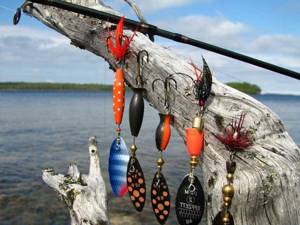
The choice of color is also one of the most important factors in successful fishing. Let's take a closer look at what colors of spinner spinners are suitable for pike. Any bait has one goal: to attract attention and provoke an attack. In spring and summer, it is better to give preference to dull colors of pinwheels, with bright splashes. In autumn, on the contrary, you can safely choose bright, fancy colors. In addition, you should also select the correct plumage of a tee or hook. A very shiny bait can scare away a pike with its unnaturalness. Dull copper and silver are a good option, matching the coloring of the scales of the fish that the toothed predator hunts.
Features of postings
It is very important to learn to control the behavior of the bait located in the water column, to feel when the spoon starts playing and maintain approximately this speed . As a rule, when catching a river predator with a spinner , a uniform retrieve is used, a wavy retrieve is more effective , in which the speed of the bait either slows down or accelerates, but its game should not stop . stepwise retrieval is possible - in this case, the play of the spinner may not stop even when it freely falls to the bottom.
Rods for spinner fishing
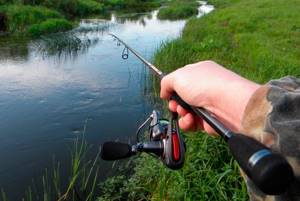
The first thing an angler should think about is rods for catching pike with spinners. The length of the spinning rod is chosen based on the size of the reservoir and terrain features. Short options are suitable if the bank is quite overgrown. The action is suitable for slow or medium. A fast rod is not the best option, as it reduces the casting distance of light lures. Super fast rods are not at all suitable for this type of fishing. It is better to choose a spinning reel, a size that is related to the length of the rod.
Choosing a spinning rod for catching large fish
Not only the comfort of fishing, but also the effectiveness of fishing depends on the correct choice of a spinning rod. The wrong “stick” can be a real punishment for an unlucky fisherman, nullifying all his efforts.
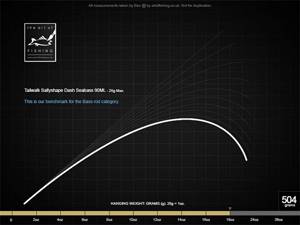
Rod length
First you need to decide where you will catch pike. It's one thing to fish from a boat, but it's another thing entirely to cast heavy baits from the shore. It is easier and more convenient to fish from a boat with a small spinning rod 2.1-2.4 m long, and long rods (2.5-3.3 m) allow you to cast bait over huge distances from the shore. By the way, if the shore is lined with trees, then it is better to use a short spinning rod, so you can avoid unwanted snags.
Design
The second thing you need to pay attention to is the design. There are three types of spinning rods: solid, telescopic and plug-in. And first of all, we are interested in the last two, since they are the most popular on the market and have the best characteristics.
Telescopic spinning rods are the cheapest and, as a rule, are used by beginners. They are not particularly reliable, but if used correctly they will last quite a long time. Their main and undeniable quality is compactness. You can throw telescopic tackle or several similar rods into your bag and calmly go fishing by public transport, without disturbing anyone.
Plug-in spinning rods are the most popular among fishermen. They consist of two or three component elbows and are famous for their reliability and high sensitivity. Such fishing rods have an optimal and precise placement of line guides, which allows them to keep the line perfectly.
Form material
Modern spinning rods are made of fiberglass, carbon fiber (carbon, graphite) and composite. Fiberglass rods are the cheapest and most flexible, but due to their heavy weight they are rarely in demand among anglers. Carbon ones are expensive, but very light. In addition, they are quite tough. Composite spinning rods are well suited for catching trophy pike; they are something in between the first two types. On such spinning rods you can find the inscription “composite” or various phrases associated with this term.
Spinning rod structure
The action of a spinning rod usually refers to the shape of the bend of the rod blank under static load.
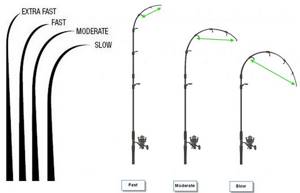
The shape of the bend depends on the material from which the rod is made, its quantity (length, thickness of the rod itself, its walls), shape, as well as the location of the guide rings, i.e. from the device, design features of the spinning rod.
Depending on the action, all spinning rods are usually divided into 4 main classes:
- Very fast action (Extra Fast) – when, under the influence of static force, approximately 1/4 of the rod is bent from the tip;
- Fast action - 1/3 of the rod bends;
- Medium action (Moderate) - approximately 1/2 of the rod bends;
- Slow action - more than 1/2 of the rod bends from the tip.
Casting test and fishing class
One of the most important parameters of a spinning rod is the casting test - this is the optimal weight of the bait to be thrown. It would seem nothing special, but this quality affects a lot. Firstly, when casting a bait that is too large, you can break the rod, and a bait that is too light simply cannot be thrown to the required distance. Secondly, the smaller the casting test, the more sensitive the rod. In addition, the spinning test affects the fishing efficiency: depending on the size and weight of the bait you use, this is the kind of fish you should count on.
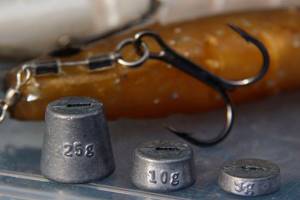
Depending on the recommended weight of the bait, spinning rods are divided into 6 classes (according to American terminology):
- Ultralight (UL) - 0-7 gr.
- Light (L) - 2-15 gr.
- Medium-light (ML) - 5-20 gr.
- Medium (M) - 10-30 gr.
- Medium-heavy (MH) - 15-40 gr.
- Heavy (H) - 30 gr. and more.
Let's say a few words about each of them to make it easier for you to make your choice.
Ultralight spinning rods are sensitive and fragile rods that are used for catching small pike. As a rule, their length does not exceed 2.1 m. When fishing with such gear, thin fishing line (0.08 - 0.18 mm) and small spoons and wobblers, the weight of which does not exceed 7 grams, are used.
The Light class allows you to use larger baits - from 2 to 15 g. The sensitivity of such spinning rods is almost the same as the lightest ones, but you can catch larger fish. Most of these models have a length of 2 to 2.5 m.
Spinning rods of the medium-light class (Medium-light) are the most common and popular “sticks” for catching pike in the fall. To some extent they can be called universal. Firstly, the spinning rod blank is strong enough to catch large fish, and secondly, it has a wide range of baits used - from 5 to 20 g. With such a rod you can hunt for medium-sized pike.
The Medium and Medium-heavy classes are used where there is a chance of catching a large pike. As a rule, these are deep reservoirs and large rivers. When fishing with such spinning rods, use a strong fishing line with a thickness of 0.25-0.35 mm or a cord. The weight of baits can reach 40 grams, which allows not only to attract a large predator, but also to quickly deliver the bait to depth. Typically, rods of this class have a length of 2.4-3.3 meters.
“Heavy” is the heaviest class. Such rods are practically not used for pike fishing and are more suitable for sea fishing.
In addition to all that has been said, when choosing and inspecting a spinning rod, you should pay attention to the following details.
The rings must be made of hard material and have a good grind. Expensive models have special ceramic inserts or rings with a homogeneous structure made of hard metals. Please note that many cheap spinning rods use low-quality plastic inserts, which leads to damage, especially when using braided cord instead of fishing line.
The spinning rods differ in their handles. It is best when the handle is made of cork: it is a very light and pleasant-to-touch material, and in cold weather the handle will warm your hand. As a rule, expensive fishing rods are equipped with such handles.
Check the handle and reel seat for defects, and also assemble and disassemble the spinning rod (plug-in) several times to ensure the tightness and reliability of the connecting tubes.
Techniques and tactics of fishing with spinners

The nature of the retrieve and its speed influence successful fishing no less than the correctly selected spinner. If fishing occurs at depth, then after casting you need to wait until the spinner reaches the bottom. Only after this can wiring begin. If fishing occurs near the surface, then retrieving should begin after the bait has touched the water. Experienced fishermen feel the bait, know how to control and hold it. Beginning spinners should learn this. When fishing for pike, uniform fishing is used at the same speed. It happens when a predator does not want to peck, then you should try wavy wiring. The speed will change and attract pike. During active feeding and biting, the retrieve should be fast. Water temperature also affects the speed of the turntable; the warmer it is, the faster it is. It has been noticed that pike bite well on stepped retrieves. The spoon is allowed to lie on the bottom, and then actively lifted. This technique will lure even an inactive pike.
Selection of baits and their color
When choosing bait, you should know that there are no clear favorites for pike; the fishing box should always contain spinners, wobblers and rubber.
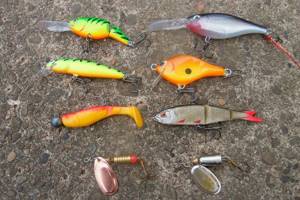
Spoons - spinners
It is good to catch pike in the fall using spinners, although many fishermen consider this bait suitable only for spring-summer fishing, but essentially it works until the freeze-up. Moreover, the pike takes both well-known imported brands and high-quality Polish, Russian and home-made products.
It is better to abandon small spinners in the fall and use sizes No. 3-5. “Four” is the most popular, because even perch in the fall prefers larger spoons, to say nothing of pike. In calm weather, spinners of the “long” type can be catchy if the retrieve is fast enough. And if the weather is rainy and windy, then slower turntables like “aglia” or “comets” perform better. The last option is somewhat preferable.
During the feeding season, pike do not have any special preferences for petal colors. An exception is that in bright sunshine, a petal covered on the outside with red reflective film works better. The advantages of large spinners include a decent casting range, efficient fishing of large areas of the reservoir, and excellent control over the retrieve. With uniform wiring, the resting petal is clearly audible, the fishing line is taut, and even a small poke from the pike is immediately felt by the hand.
At this time of year, front-loaded spoons are also popular; they have advantages when fishing in shallow depths. Such spoons work well with complex retrieves and start working almost instantly when diving.
It often happens that with a uniform retrieve, the pike chases the bait, but does not dare to grab it, or simply stands in its ambush and does not react to the lure passing by. Here, to activate the predator, some additional push in the work of the spinner will be required. You can try to work out tactics with a short-term failure of the petal or suddenly change the direction of movement of the bait. Good and reliable operation of the petal is important in small algae windows, where the length of the wiring itself is minimal. We cast and take a short pause, the spoon falls in an arc downwards, and the petal plays, then we pull it up a little and continue the game - often at this moment the pike grabs.
Spoons - spinners
Fishing with a spinner is perfect for quickly finding spots with active pike on a body of water. This type of spinners, in comparison with spinners, has a much longer range, and at the same time, it is much more difficult to master the methods of guiding the spinner, because the spinner is least suitable for the “throw the spinner and pull it evenly” type of fishing.
Therefore, we recommend following the following sequence of actions: cast, let the bait sink to the bottom, make a short jerk with the rod to tear the spoon off the bottom, and begin uneven reeling, trying to imitate the movements of a sick fish. In this case, the oscillator moves with the frequency and amplitude that was included in its design.
Sometimes, with such a complex retrieve, the pursuit of a spinner by a predator is easily felt by a series of small short strikes. In this case, there is no need to rush with a sharp hook; it should be done when the pike confidently grabs the spoon.
Wobblers, poppers and jerks
Catching toothy predators in the fall and using wobblers is effective, but you should not use too small specimens. If at the beginning of autumn the pike can respond well to small 6-7 cm wobblers, then closer to mid-October such “trifles” are ignored by the pike.
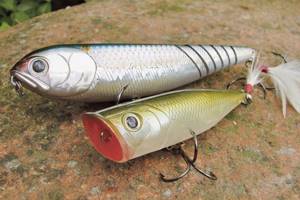
With the onset of cold weather, the pike begins to save energy and stops chasing small things, at this time the toothy one prefers larger prey. In October, lures measuring 7-8 cm and larger are suitable for pike fishing. At this time, medium and large jerks work well.
At the beginning of autumn, poppers work well in shallow water; fishing with these baits is especially effective in river backwaters, near small grassy islands, on the border of a reed. Wiring is less aggressive than summer wiring, and the pulls need to be shorter.
Silicone baits
Catching autumn pike with silicone baits such as twisters and rippers is also effective. Which one is better? Vibrating tails, the so-called rippers, have taken root in our country, despite the fact that for the most part they are somewhat more expensive than twisters. Although in many countries, in particular the USA and Canada, twisters are much more popular.
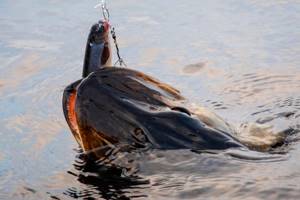
Our spinning players have found their advantages in the ripper. First of all, it is better suited for free (hinged) equipment, which is increasingly outperforming the traditional jig head. And also that the ripper, unlike the twister, more realistically imitates the main food of a predator - a small fish.
And if when catching small predatory fish this is not so significant, then when hunting for large pike these factors come into force: the natural appearance and action of the bait, which produces vibrations that are in many ways similar to the movement of live fish - the prey.
Some fishermen argue that the color of rubber for pike does not play a big role, but at shallow depths the influence of color on the bite is quite significant, because here the visibility is excellent and the colors retain their original hue in the water. First of all, before catching pike with rubber, you need to pay attention to the transparency of the water. If the water is clear, color can play a decisive role in the performance of lures, often even more so than their performance.
In the morning, you should try to fish with light rubber, but if the sun is already high and the water column is well lit, then the first thing you need to do is put on dark rubber - “oil” and gray-lead shades are ideal, especially if the bottom at the fishing spot is sandy. In these same conditions, red-colored rubber can work well. This color can help out the angler in times of lack of bite, when the pike begins to be capricious and rejects baits of a different color.
In bad weather, you should try to fish with brighter rubber options, but not “acid” tires. These are still imitators, with colors similar to the natural food of pike.
Sometimes the inexplicable happens - only rubber of the most “piercing” brightest colors works, even in the sun and clear water, when the bottom is visible at a depth of two meters. Therefore, if the bite is weak, it is always worth trying to fish with acid baits. But the main purpose of very bright rubber baits is fishing in the morning and evening dawns, when for a predator all objects are “blurred”, but the bright colors are visible quite well.
In early autumn, when the water in many reservoirs is not yet clear enough, the influence of color on the predator’s bite is significantly reduced, but bright rubber still gives more bites. It is not without reason that many spinning anglers fishing in muddy water often use only “acid” baits, not recognizing baits of other colors at this time.
Advantages and disadvantages of turntables
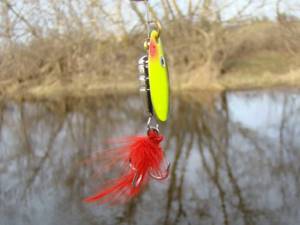
The main advantages of turntables are their simple design and the ability to carry out independent repairs if necessary. In addition, turntables are one of the most catchy baits for predators, including pike. The huge market for spinners makes it possible to purchase high-quality bait at an affordable price. In addition, the spinner is a 100% working bait. Its use does not require special skills, and even novice spinning anglers can fish with it.
The spinners have no disadvantages as such, except for the possible twisting of the fishing line. However, this drawback is quickly eliminated. It is necessary to either bend the tip of the rod or replace the fishing line with braided one.
Oscillating lures for pike
The “Crocodile” spinners have a built-in double, but there are non-snagging models with a tee or a double on the winding ring, where the non-snagging wire is attached from the eye of the tee to the tip
Oscillating spoons are considered one of the oldest artificial baits. They were traditionally used to catch pike. But even now, despite the popularity of wobblers and silicone fish, the spinner takes its place of honor in the spinner’s box.
Among the main advantages of the vibrator it is worth noting:
- long cast;
- different fishing line rewind speeds;
- the use of different wiring techniques;
- low cost.
The most popular vibrators are the models that have been proven over the years:
- "atom";
- "storling";
- "Queen of the Dnieper"
High-quality oscillating spoons are produced by such well-known manufacturers as:
- Mepps;
- Kuusamo;
- Spinnex;
- Wirek;
- Abu Garcia;
- Condor;
- ACME;
- Red Hunt;
- Jaxon.
Rating of the best-selling spinners and spinning lures at low prices! Readers have already joined in shopping from China on Aliexpress. Join us too.
Many Chinese and Russian models are in no way inferior to famous brands. This is explained by the fact that modern equipment allows you to easily repeat the geometric parameters of the spinner. Therefore, pike can be caught with almost any bait, if it is presented correctly and attractively held.
- The color of the oscillating spoon is selected depending on the transparency of the water and weather conditions. But even when fishing in the muddiest water, you should not polish the surface to a mirror shine. And in bright sunny weather, experienced spinning anglers specially darken the spinners in the flames of the fire.
- Spoon baits of different colors attract pike well. For example, a catchable bait is one that is painted red on one side and black on the other.
- Excellent results are shown by models made from two different metals. An example is the Spinnex Pike 2.
- Oscillating spoons can be made in the form of non-snacking baits. With such a spoon, it’s not scary to fish in snags or in thickets of grass. Wire antennae prevent hooks from snagging, and when a pike bites, they bend, exposing the sting of the hook.
- Spinner baits allow you to hunt for pike from a boat using the vertical trolling technique . It is especially effective in tight spaces among snags or algae windows. In this way, it is best to catch a predator in late autumn, when trophy fish concentrate in the deep places of the reservoir.
The best spinners for pike
The modern fishing market offers spinners for every taste, size and budget. Below is the rating of the top 10 best catching spinners for pike. These spinners have been tested by time and by professional spinners.
Blue Fox Vibrax Super Bou
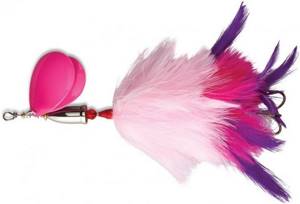
The American subsidiary of Rapala, Blue Fox, produces high-quality and catchable baits. The Blue Fox Vibrax Super Bou series spinners were designed specifically for pike hunting. The design of the spoon makes it very attractive to predators. The round shape of the petal emits a strong vibration, which the fish picks up even from afar. The body is made of steel, and the plumage is made of natural marabou feathers. This spoon has proven itself to be excellent when fishing for large prey. The tandem of the petal and plumage creates a realistic composition for the pike, and makes it rush to attack with lightning speed.
Daiwa Silver Creek Spinner
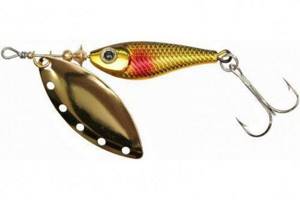
Daiwa Silver Creek Spinner spinners have proven themselves to be catchy baits. The Silver Creek Spinner stands apart. The spinner is light in weight. The catchability of this bait lies in its unique structure. The complex curve of the petal is combined with a core made of two types of metal of different weights. This spoon has proven itself to be excellent both in strong currents and in calm water. Japanese spinners from Daiwa are popular among fishermen all over the world.
Savage Gear Caviar Spinner
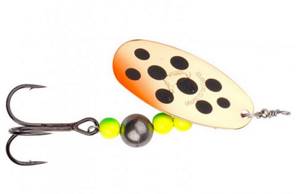
The Savage Gear company produces catchable baits for predators. Their meticulous approach to business allows us to consider these baits as one of the most efficient. Savage Gear Caviar Spinner has a simple, but very effective structure. The surface of the spoon is matte on one side and shiny on the other. The bright feature of the bait of this line is the cambric, which is put on the shank of the hook. This additionally attracts the predator and makes it attack.
Mepps Black Fury
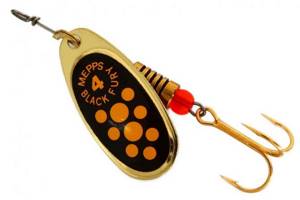
Without a doubt, the favorites of the world market for the production of turntables are the French company Mepps Black Fury. The turntables of this company are very popular among both professionals and beginners. Mepps produces many lines of spinners. Black Fury - this lure in the fishing world is called the most catchy bait of all time. “Black Fury” has 4 numbers from 1 to 4 in order of increasing size. Perhaps the main secret to the success of fishing with this bait is its color. The spinner is black in color and this is precisely the phenomenon of its catchability. Black bait is noticeable in any water. It contrasts in clear water, and is clearly visible in cloudy water. The bait does not scare away fish. For several decades, “Black Fury” has been an all-time favorite for many spinners.
Mepps Aglia long
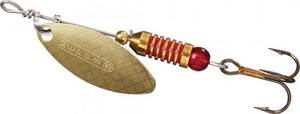
The Aglia long spinner from the same Mepps brand has proven itself to be excellent. This spoon, like the Black Fury, is the old guard of the company. This model is the most titled in the fishing world. The main secret of this turntable is in its structure. The shape of the petal has a deviation from the axis and drag. It changes with the wiring speed. With a wide speed range, the ideal performance of the spinner is maintained. This contributes to record catch rates. This spoon is ideal for beginners, as it forgives mistakes made due to inexperience. A rotating spoon works both in strong currents and in calm water in the lake.
{banner_vnutri-kontenta-3}
Mepps Comet
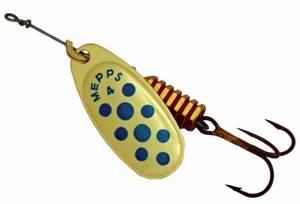
The Mepps brand has a large line of Comet turntables. This is a very popular series of turntables. The numbering of this series starts from 1 to 5. The petal of the “comet” is of medium width, which makes it quite universal. This spinner can be successfully used both in current and in still water. Meps spinners for pike are available in two colors: silver and gold. On the surface there are red or blue peas, depending on the number of the spinner. This bright color attracts predators.
Mepps Lusox
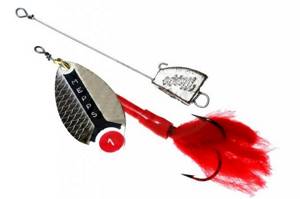
Lusox from Mepps is an ideal spinner for inactive pike. With its structure, it will force the sleepiest pike to rush into the hunt. The weight heads of this bait are replaceable. The petals combine two colors: gold and silver. Its structure allows it to create strong vibrations under water. The spinner makes it possible to replace the tee, which in the original is disguised with a red edge. This makes it possible to avoid snags, since sometimes you have to fish for predators in very overgrown reservoirs. This spoon is designed specifically for pike fishing.
Kuusamo Kuf
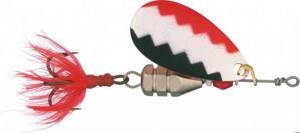
The Finnish company Kuusamo has proven itself in the fishing products market. Their high-quality spoons are designed to catch predators, in particular pike. A special game of pinwheels can stir up the sleepiest fish. Their baits are made from environmentally friendly materials. Each spinner undergoes a thorough quality control check. Kuusamo Kuf universal spoon. It is attached to the leash on both sides, this allows you to choose the lure to suit the mood of the predator. The Kuusamo Kuf spoon has snag protection, a sharp tee and an attractive red fly.
Lucky John Shelt Blade
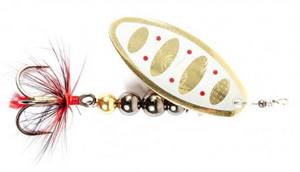
The Latvian company Lucky John produces quite innovative spinners on the market, with a standard appearance. The Lucky John Shelt Blade series spinners have a long petal shape and are painted on both sides. On the background, bronze or copper color, there are spots and colored dots. The Shelt Blade series is available in 5 sizes. The bait is modeled on a computer, which ensures its stable operation. The core of the turntable consists of tungsten balls.
Pontoon 21 Ball Concept
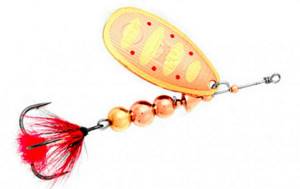
Ball Concept – catchy spinners from the Pontoon21 brand. The set of cores for this spoon consists of balls of different diameters. The shifted center of gravity gives the helicopter excellent flight characteristics. The coloring of the petal creates an original visual effect and makes the spinner even more attractive to fish. The spinner performs well in fast water.
The modern market offers a huge selection of spinners for every taste and color. There are many classic models whose manufacturers have remained true to themselves for several decades. In addition, the modern fishing market is constantly improving, and new catching models are being developed. In the huge variety of fishing market, every spinner will find a bait to his liking. Beginning fishermen, who have tried spinners at least once in their lives, always leave them in their fishing boxes. In addition, no predator fishing is complete without a high-quality and catchy spinner.
Features of autumn pike fishing
Autumn weather, with its frequent rains, sharp gusty winds and a steady decrease in air temperature, also leaves its mark on the behavior of fish. Pike, which loves cool weather and is accustomed to hiding in holes and underwater springs in summer, becomes unusually active as the weather gets colder.
From the beginning of autumn, the fish eat up before the long winter, and therefore in September the pike begins its most intense and rather long autumn feeding. Pike fishing in the fall (September and October) is the most successful compared to other seasons, regardless of the fishing method, because the fish equally greedily rushes to almost any bait, be it an oscillating spoon, wobbler or live fish.
By the end of autumn, the behavior of pike changes radically. The fish on which it feeds gather in schools and descend closer to the bottom for the winter. Pike, along with other predators, accompanies such schools without showing much activity, since it has already gained enough fat to survive the winter safely. Pike fishing in November is still possible in open water, in those reservoirs where there is no ice, but fishing at this time is usually unpredictable, and the chance of going without a catch is very high.
September
On a large reservoir, a large river or an extensive lake, fishing for pike in September with a spinning rod is possible both by casting and by trolling. For trolling, all summer baits, wobblers and spinners that work at medium depths are currently used; it is possible to use wobblers with a more active game.
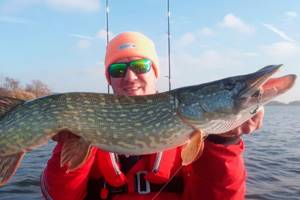
But for casting spinning fishing, changes in the composition of baits begin. Even larger and more voluminous baits are replacing the very small ones that we used to catch pike in July and the slightly larger spoons and wobblers that we used to catch pike in August.
In the fall, the season for pike fishing with jerky begins. It is in September that these volumetric baits work effectively, to which the predator responds adequately at this time.
They use jerk tackle - powerful short rods with a length of 120-185 cm and a test weight of 60 to 200 grams, thick cords with a diameter of 0.24 mm and baitcasting reels from size 300. Naturally, the accessories and leashes also match all other gear.
Also in September, jig tackle begins to work effectively again. And if the “dzhigits” switched to other baits, spoons and wobblers in the summer months, July and August, then in September they return to their favorite pastime.
Large silicone up to 20 cm long, jerky 10-15 cm, large block wobblers 8-15 cm, spinners 4-6 numbers, large flat wobblers like Kuusamo Professor work well on pike.
In general, September fully justifies its title as one of the best pike months, when there is hope of catching a trophy, the photo of which will warm the fisherman’s heart all winter, showing off on the computer screen throughout the long winter ahead.
October
October is an interesting month. From a fishing point of view, this is not summer at all and not even the beginning of the autumn spinning Eldorado.
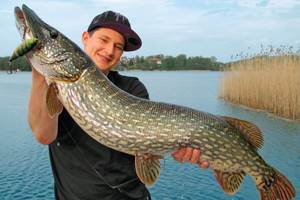
And at the same time, the fish have already moved from their summer “apartments” and are in the process of migrating from shallow water to the deepest parts of reservoirs.
It is already pointless to look for fish in the shallows at this moment, although back in September it was possible to successfully catch pike in these places, especially in warm, windless weather, close to summer feeding areas.
In October, pike fishing with spinning rods becomes possible in large bodies of water only from a boat. If back in August it was possible to successfully fish from the shore, using even small wobblers, and in September you could still get the predator from the shore using long-range spinning rods and jig baits, then in October all fishing is done from a boat.
The exception is in places where, on large bodies of water, the river bed passes directly under the shore, within the casting range of spinning rods 3.0-3.3 meters long - 100-120 meters. In such places, the jig again rules and you can still catch pike with a castmaster or other heavy cut lures.
From a boat, pike fishing takes place according to the “spring scheme”. Combing channel dumps, breaking through the upper edges, catching channel snags and interesting places on large reservoirs. Jig, heavy wobblers with a depth of up to 7-9 meters, heavy spinners, spinners number 5-6 with loading and refilling with silicone.
As for small reservoirs, in October the “real feast” begins on them. The fish are no longer smeared throughout the pond, the pike begins to concentrate. And here the “spring” places are starting to work again.
A reverse movement occurs, peaceful fish and predators begin their final shift from summer feeding areas to wintering areas, and a process of movement to wintering pits occurs.
In October, pike is caught every day in small reservoirs; it is worth finding places where forage fish are concentrated, and where there is an active autumn predator.
November
The food fish move to deeper and deeper places, closer to the wintering pits, and the predator, like a wolf after sheep, moves in the same direction. Until recently, at the very beginning of autumn, it was possible to catch pike on dumps and edges in the upper and middle horizons of the reservoir.
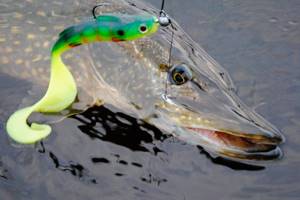
Now, at the end of autumn, pike bites mostly occur on the lowest horizons of channel dumps. The predator stands in the pits, at the entrances to the pits and at the exits from them, and picks up rich prey from forage fish. Belle clusters in large schools, and where there is bustle, there are carefree fish.
In November, trophy pike are caught using spinning rods at the exits from the bays of reservoirs to the main channel, where the so-called “ribs” are formed.
In such places, the pike waits for schools of roach and bream crossing over the underwater hills. Here she has the opportunity to attack prey from below, standing at the very base of such a “rib”.
On small rivers, the most promising places are deep holes in the river, which are wintering grounds for fish. Pits under pits and holes at the confluence of two small rivers, where the mutual current digs out fairly decent depressions in the soft muddy bottom, also work great, bringing solid specimens to the pike angler’s catch.
On lakes from which fish do not fall into rivers and deep channels for the winter, all white and predatory fish accumulate in the deepest places. Now you don’t need to look for the predator along the hills and islands, it is all over several points. And if these points are known in advance, then fishing for them is more reminiscent of fishing in an aquarium - casting, retrieving - biting.
Shore fishing for pike in November using a spinning rod is only possible where the channel edges are within casting distance from the shore. There are no pike now on the mounds and on the upper boundaries of the dumps - they are all at depth. Therefore, many summer and early autumn points do not work.
Without any exaggeration, we can say that November is the month of jig. Not only the spotted predator is caught on a jig in November, but also the striped and fanged ones.
Any jig bait is used - pike are caught on a mandula, foam rubber, silicone, polyurethane foam. Using dead fish on a rig shows excellent results. It is, of course, better to select fish in the likeness of those found in the fished reservoir.
Which jig to use for pike in November? The weights are the most ordinary, but the baits are of the most gigantic sizes. Before the freeze-up, pike hunt for the largest representatives of the carp family, so the largest replicas of roach or bream will come in handy.
Wiring turntables in the current
Another important feature of rotating spoons is that their play is determined by the oncoming flow of water. Therefore, wiring at different angles to the current has its own subtleties, because here the petal is additionally influenced by the strength of the current. If the wiring is carried out against the stream, the flow helps and the rotation of the petal accelerates, while along the stream the rotation slows down.
The most difficult part is wiring across the stream. In this case, the current acts especially negatively, disrupting the “flow around” the petal and interfering with proper play. It gets to the point that some models in some transverse sector stop rotating until they stand at an angle of less than 60° to the jet.
Therefore, the fishing area in fast currents can be divided into several zones (Fig. 2).
Fig.2. Zones in the fishing area in the presence of a current: 1) upper coastal, 2) reserve, 3) “dead”, 4) main, 5) lower coastal.
The cast is usually made into the “dead” zone - taking into account the fact that while the spoon reaches the required depth, it will just be carried to the beginning of the working zone. There, on the stream, the petal already begins to rotate stably only due to the flow. To prevent the bait from being thrown to the surface, wiring in the working area can be carried out even without reeling in the fishing line - for demolition. At the same time, sometimes they slightly shake the tip of the rod, forcing the spinner to move in short jerks all the way to the shore. Near the shore, the spoon is usually brought to the surface, and it is simply reeled in.
However, the fish often stands close to the shore. In this case, we need the spinners with the slowest and fastest rotation. We throw the first one downstream, and the second one upstream, and carry it along the shore.
Fishing upstream in zones 1 and 2 is more difficult, as it requires easy-to-play spinners and fast retrieves. Therefore, it is not particularly popular, but in vain. After all, it is easier for many predators to pursue their prey downstream, and there is almost no time to think here: lunch floats away!
Once I walked back and forth several times along a fast riffle, where a medium-sized asp was actively “beating” - and the catch was distributed approximately equally. Perhaps the fact that when moving downstream the spoon went deeper also played a role. So don't forget about this option.
rybalkaspinning.ru
